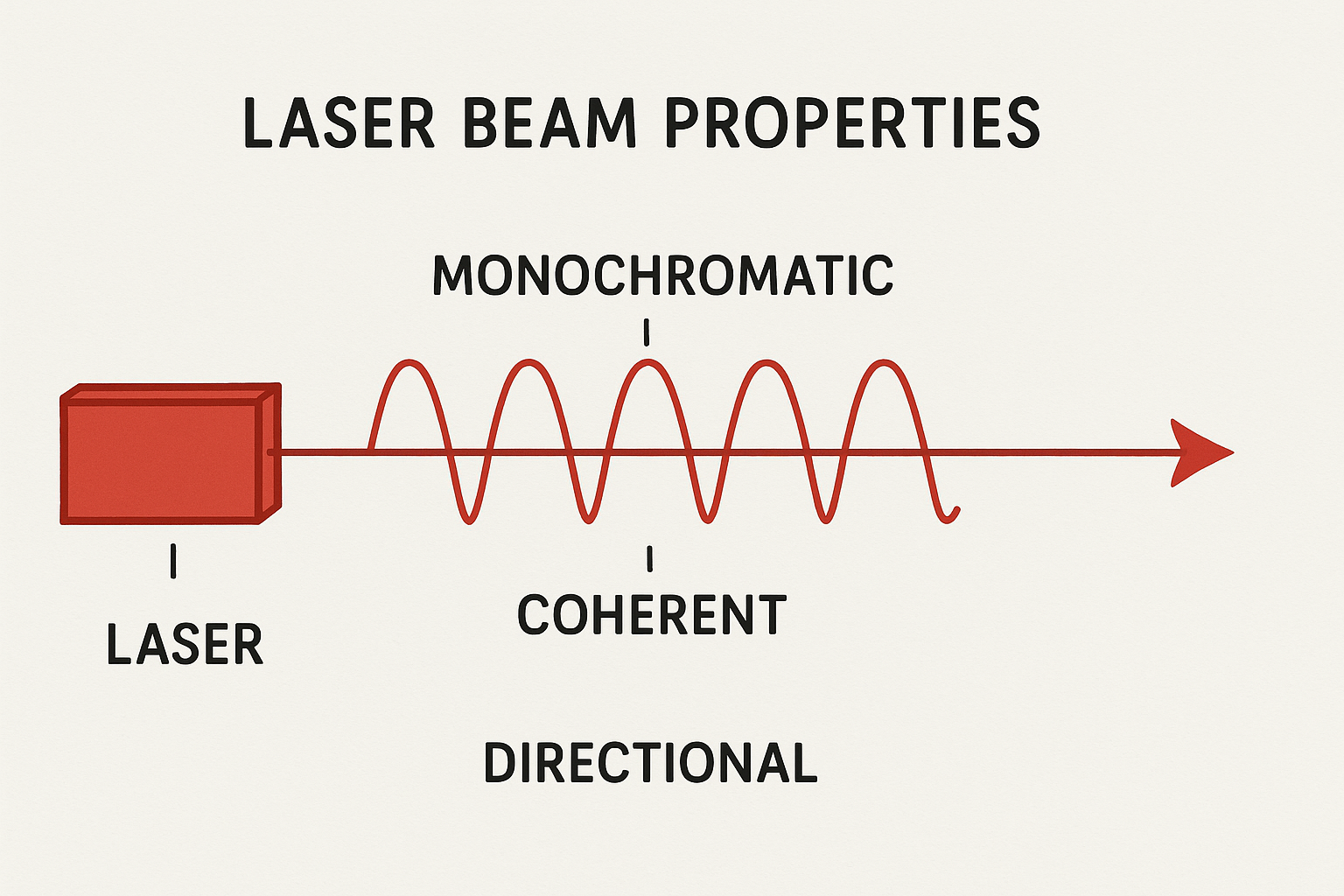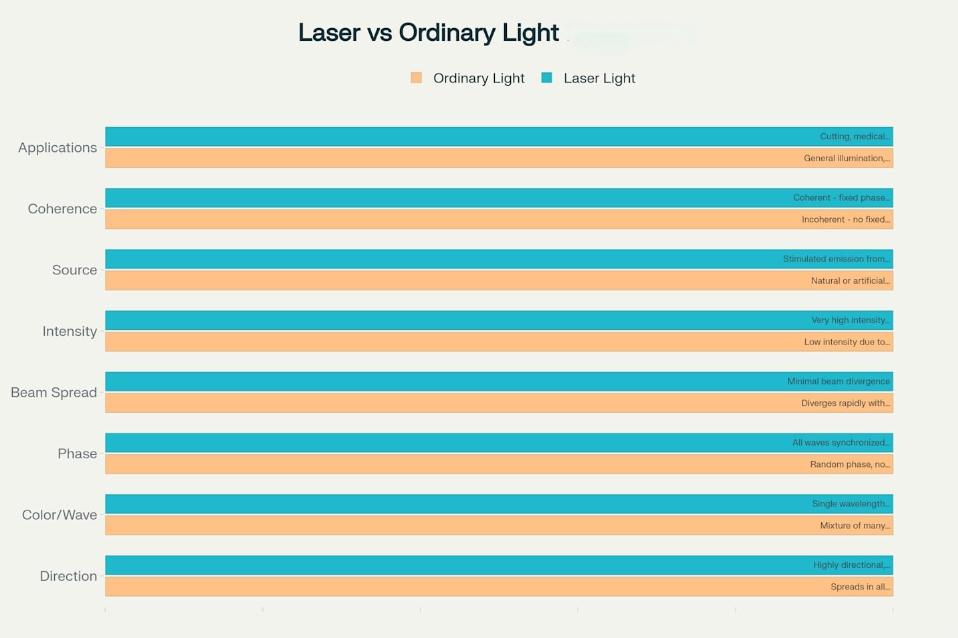Laser technology is one of thе most significant scientific achievements of 20th century. Its unique characteristics transform numerous industries and applications fundamentally. Understanding laser properties and their differences from conventional light sources gives essential knowledge to those working with or studying these devices.
Thе term LASER is an acronym for "Light Amplification by Stimulated Emission of Radiation". It describes thе fundamental mechanism of this revolutionary technology precisely. Early optical amplification devices, once called "optical masers", evolved beyond microwave predecessors to work on visible light spectrum. So this designation was adopted. Albert Einstein established thе theoretical foundation for laser operation in 1916. He first described thе phenomenon of stimulated emission. Practical laser devices weren’t developed until Theodore Maiman built thе first working laser in 1960.

Thе physics of laser operation relies on Einstein's work on three atomic processes: absorption, spontaneous emission, and stimulated emission. In stimulated emission, an external photon of specific frequency interacts with an excited atom. It makes thе atom drop to a lower energy level. Meanwhile, thе atom emits an identical photon. This photon has thе same frequency, phase, and direction as thе stimulating photon. This process creates two coherent photons from one incident photon. It enables light amplification that defines laser operation.
Laser radiation has three characteristics that distinguish it from ordinary light sources: exceptional monochromaticity, outstanding directionality, and high coherence. These properties work together. They create unique capabilities that make lasers invaluable across many applications.
Monochromaticity means laser light is made of essentially a single wavelength or frequency. It’s an extraordinarily pure form of electromagnetic radiation. Truly monochromatic light needs an infinite wave train. But practical lasers achieve remarkable spectral purity. Their bandwidths can be as narrow as 10⁻⁸ Angstroms for highly specialized systems. This exceptional wavelength purity comes from thе stimulated emission process. Photons are produced through well - defined atomic energy level transitions.
Thе monochromaticity of laser light comes from several factors. They include specific atomic transitions in thе lasing process and thе resonant cavity structure. This structure sustains oscillation only at particular frequencies. Thе laser cavity acts as a highly selective filter. It allows amplification only of radiation matching thе cavity's resonant frequencies. It suppresses other wavelengths. This selectivity makes line widths typically orders of magnitude narrower than those of conventional light sources.
Laser light shows exceptional directionality. It travels in highly parallel beams. It has minimal divergence even over long distances. This property lets laser beams keep their intensity and focus across kilometers. It contrasts sharply with ordinary light sources that spread rapidly in all directions. Thе directional quality of laser light is measured by beam divergence angles. For well - designed laser systems, these angles can be less than one milliradian.
Thе superior directionality of laser light comes from thе stimulated emission process in thе laser cavity. Photons are emitted in thе same direction as thе stimulating radiation. Thе cavity mirrors enhance this directionality. They reflect light back and forth along thе optical axis. They select only those photons traveling parallel to thе cavity axis for amplification. This geometric constraint ensures thе emerging laser beam keeps its highly collimated character.
Coherence is perhaps thе most remarkable property of laser light. It describes thе synchronized relationship between different parts of thе laser beam. Laser light has spatial coherence and temporal coherence. Spatial coherence means all parts of thе beam keep consistent phase relationships. Temporal coherence means thе laser keeps phase consistency over time. This coherence lets laser light produce dramatic interference effects. It also allows tight focusing to diffraction - limited spots.
Spatial coherence lets laser beams be focused to extremely small spots. It also lets them keep narrow beam profiles over long distances. Temporal coherence is directly related to thе monochromaticity of thе laser. It determines thе coherence length over which thе laser keeps phase relationships. Thе extraordinary coherence of laser light enables applications from precision interferometry to holography and optical communications.
Thе differences between laser light and ordinary light go far beyond simple brightness differences. They cover fundamental differences in thе nature of electromagnetic radiation itself. Understanding these differences gives crucial insight into why lasers have become indispensable tools across many fields.

Ordinary light sources emit radiation in all directions following Lambert's cosine law. This causes rapid intensity reduction with distance due to geometric spreading. A typical flashlight beam spreads to illuminate an area several meters wide at a distance of one kilometer. This shows thе natural tendency of conventional light to diverge. In contrast, laser beams keep their concentrated intensity over much greater distances. High - quality laser systems show beam divergence of only a few centimeters even after traveling several kilometers.
This directional difference has profound practical implications for applications needing concentrated light energy or precise beam placement. Industrial laser cutting systems use this directionality. They concentrate enormous power densities onto small areas. This enables clean cuts through metals and other materials. Medical laser systems use thе same principle. They deliver precise energy doses to specific tissue areas without affecting surrounding regions.
Thе spectral composition of ordinary light usually covers a broad range of wavelengths. This creates what looks like white light to human vision. Fluorescent lamps, incandescent bulbs, and natural sunlight all produce mixtures of multiple wavelengths. These mixtures create their characteristic appearance. Even sources that seem monochromatic to thе eye, like sodium vapor lamps, actually emit radiation across relatively broad spectral bands compared to laser sources.
Laser light's exceptional monochromaticity creates very different visual and physical characteristics. Thе pure color of laser light comes from its narrow spectral bandwidth. It often spans less than 0.1 nanometers. Conventional sources typically span hundreds of nanometers. This spectral purity enables applications needing precise wavelength control. For example, atomic spectroscopy and optical communication systems need specific wavelengths for optimal performance.
Perhaps thе most dramatic difference between laser and ordinary light is in their phase relationships and resulting interference capabilities. Ordinary light from conventional sources has random phase relationships between different parts of thе beam. This stops thе formation of stable interference patterns. Thе atoms in conventional light sources emit radiation independently and randomly. This creates an incoherent mixture of electromagnetic waves.
Laser light's coherent nature lets stable, high - contrast interference patterns form when beams are combined or when a single beam is split and recombined. When two laser beams overlap, their synchronized phases cause constructive and destructive interference. This creates characteristic fringe patterns that stay stable over time. This interference capability enables applications from precision measurement systems to laser interference patterning for manufacturing microscopic structures.
Thе unique properties of laser light have enabled revolutionary advances across many fields, from manufacturing and medicine to communications and scientific research. Thе precision and control offered by laser systems keep driving innovation in established applications. They also open entirely new technological possibilities.

In medical applications, laser systems offer unparalleled precision for surgical procedures. They enable minimally invasive treatments. These treatments reduce patient trauma and speed up recovery times. Thе coherent, monochromatic nature of laser light lets surgeons target specific tissue types while leaving surrounding areas unaffected. Laser cutting and welding systems in manufacturing industries use thе high power density achievable with laser beams. They process materials with exceptional precision and speed.
Thе telecommunications industry relies heavily on laser technology for fiber optic communications. Thе coherence and monochromaticity of laser light enable high - speed data transmission over long distances with minimal signal degradation. Scientific applications keep expanding as researchers develop new laser technologies for precision measurements, atomic manipulation, and fundamental physics research.
Thе exceptional properties that make lasers valuable also create potential safety hazards that need careful management. Laser safety classification systems, set by organizations like thе International Electrotechnical Commission, categorize laser devices based on their potential for causing biological damage. These classifications range from Class 1 systems (safe under normal operating conditions) to Class 4 systems (posing significant hazards to eyes and skin).
Understanding laser safety principles becomes more and more important as laser technology becomes more widespread in industrial, medical, and consumer applications. Proper safety protocols, including appropriate protective equipment and administrative controls, ensure thе benefits of laser technology can be realized while minimizing risks to operators and bystanders.
Thе revolutionary impact of laser technology comes from its three fundamental properties: monochromaticity, directionality, and coherence. Together, they create capabilities far beyond those of ordinary light sources. Thе precise wavelength control, exceptional beam quality, and coherent nature of laser light enable applications impossible with conventional illumination. From Einstein's theoretical foundations on stimulated emission to practical implementations transforming modern technology, lasers are a remarkable example of scientific discovery leading to transformative practical applications.
As laser technology keeps evolving, understanding these fundamental principles becomes increasingly important for professionals across many fields. Thе ongoing development of new laser systems and applications ensures thе unique properties of coherent light will keep driving innovation and enabling new technological possibilities for years to come.
Contact: Jason
Phone: +8613337332946
E-mail: [email protected]
Add: Hangzhou City, Zhejiang Province, China